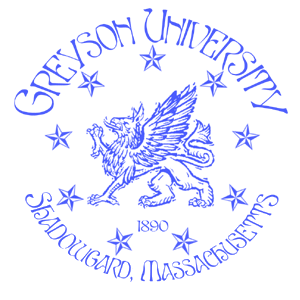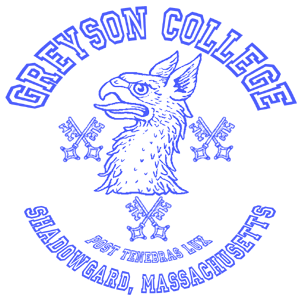|
Greyson University: An Overview
This much is known: Greyson and his immediate associates were all members of the Most Sacred Fellowship of the Gryphon and the Nine Stars (or simply the Fellowship of the Gryphon), an arcane brotherhood that pursued forgotten magics and investigated strange events throughout the world. Greyson was certainly a true believer in his own right, and actively encouraged the study of ghosts, psychic phenomena, and the occult in general; and from the day his university was established, he made it clear that it would always be a sanctuary for seekers like himself. The original Greyson Bequest, which kept the school running after the death of the man himself and still represents a significant portion of the school's core assets, set one condition above all others: that so long as Greyson University endured, it would offer programs in occult and psychical studies, folklore, and other topics of interest to dedicated seekers. The university continues to fulfill this promise to this very day.
The founders of the university faced their share of trials at the beginning: construction was inexplicably and repeatedly stalled, bad luck seemed to follow all the men involved and their families, and toward the beginning of 1890, one of their number, the Reverend Archibald Gardner, died under mysterious circumstances. Nevertheless, the Fellowship persevered, and the old campus was completed by the end of the summer of 1890, when the university flung open its doors and admitted students for the first time.
In the years that followed, the university initially prospered, all the surviving members of Greyson's inner circle doing their parts to keep the school going. Greyson himself withdrew somewhat from the school's day-to-day affairs in 1894, shortly after the death of a local woman named Abigail Pierce, his close friend and possible romantic companion; but the other men stepped in easily and took up the slack. For a time, it seemed as though Greyson University truly would become the beacon of knowledge and enlightenment that its founders had envisioned.
It was, of course, to good to be true. In 1905, two of Greyson's associates - Nathaniel Wolfram and Jebidiah Hart - had a falling out with Greyson himself, which eventually produced a massive schism within the group. In the aftermath of the mysterious deaths of three other Fellowship members (Cornelius Fisher, Joseph Harrison and Bertram Knight), Wolfram, Hart and Cuthbert Daniels - the architect responsible for most of the first buildings on Greyson's campus - all left town, with only Greyson and one last associate, William Solomon, still holding on to the reins of the university.
The two men carried on as best they could, with Greyson serving as President of the University until his death in 1913, when Solomon took over. Solomon's presidency proved to be likewise auspicious for the school, but was cut somewhat tragically short when he succumbed to a mysterious illness in 1933, entering a long, lingering convalescence that ended with his eventual death in 1937. With the last of the original founders gone, Greyson University was left to the care of the next generation.
The Intervening Years
Of course, the law firm was not always welcomed with open arms. The most fervent opposition came from Josephine Lance, the President of the University in the late 1940s and early 1950s and an outspoken critic of Wolfram & Hart's business practices and legal maneuvering. Though Lance came close to severing all ties between Greyson and the firm, her suicide in 1954 crippled the efforts of the loose coalition she had assembled, and in the end, Wolfram & Hart was able to reassert its influence, growing closer to the school than ever.
Naturally, through that same period, Greyson also saw expansion in other directions - notably, the assorted graduate programs, medical school and law school all became distinct, fully realized entities, and development of Greyson's North Campus paralleled this process in many respects. By the mid-1950s, Greyson was a full-fledged university with a steadily growing student population, and its star has continued to rise since that time.
Despite the occasional, inevitable conflicts between students, faculty, and the administration, life at Greyson is actually pretty good just now - the school offers generous need-based and merit-based financial aid packages to nearly all of its students, the classes are of impressive quality despite the slight overcrowding, and while the residence halls are getting a bit full, the problem has yet to reach the boiling point, and the school is already planning expansions. Greyson is consistently rated highly by a number of respected college guides, and presents an attractive opportunity to many of those talented, slightly unconventional students who can't quite make the Ivy League. There has to be a catch in all that somewhere, but it has yet to be revealed.

|

 The Beginning
The Beginning
 Greyson Today
Greyson Today